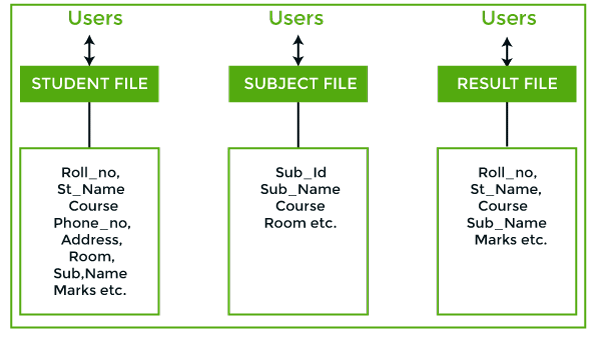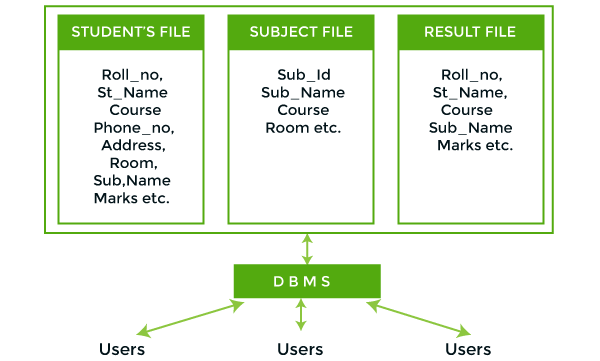If you are interested to learn about the MySQL Features
File System Approach
File based systems were an early attempt to computerize the manual system. It is also called a traditional based approach in which a decentralized approach was taken where each department stored and controlled its own data with the help of a data processing specialist. The main role of a data processing specialist was to create the necessary computer file structures, and also manage the data within structures and design some application programs that create reports based on file data.
File System :
The file system is basically a way of arranging the files in a storage medium like a hard disk. The file system organizes the files and helps in the retrieval of files when they are required. File systems consist of different files which are grouped into directories. The directories further contain other folders and files. The file system performs basic operations like management, file naming, giving access rules, etc.
Example: NTFS(New Technology File System), EXT(Extended File System).

In the above figure:
Consider an example of a student’s file system. The student file will contain information regarding the student (i.e. roll no, student name, course etc.). Similarly, we have a subject file that contains information about the subject and the result file which contains the information regarding the result. Some fields are duplicated in more than one file, which leads to data redundancy. So to overcome this problem, we need to create a centralized system, i.e. DBMS
DBMS:
A database approach is a well-organized collection of data that are related in a meaningful way which can be accessed by different users but stored only once in a system. The various operations performed by the DBMS system are: Insertion, deletion, selection, sorting etc.

In the above figure,
In the above figure, duplication of data is reduced due to centralization of data.
There are the following differences between DBMS and File systems:
| Basis | DBMS Approach | File System Approach |
|---|---|---|
| Meaning | DBMS is a collection of data. In DBMS, the user is not required to write the procedures. | The file system is a collection of data. In this system, the user has to write the procedures for managing the database. |
| Sharing of data | Due to the centralized approach, data sharing is easy. | Data is distributed in many files, and it may be of different formats, so it isn’t easy to share data. |
| Data Abstraction | DBMS gives an abstract view of data that hides the details. | The file system provides the detail of the data representation and storage of data. |
| Security and Protection | DBMS provides a good protection mechanism. | It isn’t easy to protect a file under the file system. |
| Recovery Mechanism | DBMS provides a crash recovery mechanism, i.e., DBMS protects the user from system failure. | The file system doesn’t have a crash mechanism, i.e., if the system crashes while entering some data, then the content of the file will be lost. |
| Manipulation Techniques | DBMS contains a wide variety of sophisticated techniques to store and retrieve the data. | The file system can’t efficiently store and retrieve the data. |
| Concurrency Problems | DBMS takes care of Concurrent access of data using some form of locking. | In the File system, concurrent access has many problems like redirecting the file while deleting some information or updating some information. |
| Where to use | Database approach used in large systems which interrelate many files. | File system approach used in large systems which interrelate many files. |
| Cost | The database system is expensive to design. | The file system approach is cheaper to design. |
| Data Redundancy and Inconsistency | Due to the centralization of the database, the problems of data redundancy and inconsistency are controlled. | In this, the files and application programs are created by different programmers so that there exists a lot of duplication of data which may lead to inconsistency. |
| Structure | The database structure is complex to design. | The file system approach has a simple structure. |
| Data Independence | In this system, Data Independence exists, and it can be of two types.Logical Data IndependencePhysical Data Independence | In the File system approach, there exists no Data Independence. |
| Integrity Constraints | Integrity Constraints are easy to apply. | Integrity Constraints are difficult to implement in file system. |
| Data Models | In the database approach, 3 types of data models exist:Hierarchal data modelsNetwork data modelsRelational data models | In the file system approach, there is no concept of data models exists. |
| Flexibility | Changes are often a necessity to the content of the data stored in any system, and these changes are more easily with a database approach. | The flexibility of the system is less as compared to the DBMS approach. |
| Examples | Oracle, SQL Server, Sybase etc. | Cobol, C++ etc. |
Features of a File system
Here are important elements of the file system:
- It helps you to store data in a group of files.
- Files data are dependent on each other.
- C/C++ and COBOL languages were used to design the files.
- Shared File System Support
- Fast File System Recovery.
Features of DBMS
Here, are essential features of DBMS:
- A user-accessible catalog of data
- Transaction support
- Concurrency control with Recovery services
- Authorization services
- The value of data is the same at all places.
- Offers support for data communication
- Independent utility services
- Allows multiple users to share a file at the same time
KEY DIFFERENCES:
- A file system is a software that manages and organizes the files in a storage medium, whereas DBMS is a software application that is used for accessing, creating, and managing databases.
- The file system doesn’t have a crash recovery mechanism on the other hand, DBMS provides a crash recovery mechanism.
- Data inconsistency is higher in the file system. On the contrary Data inconsistency is low in a database management system.
- File system does not provide support for complicated transactions, while in the DBMS system, it is easy to implement complicated transactions using SQL.
- File system does not offer concurrency, whereas DBMS provides a concurrency facility.
Advantages of File system
Here are pros/benefits of file system:
- Enforcement of development and maintenance standards.
- Helps you to reduce redundancy
- Avoid inconsistency across file maintenance to get the integrity of data independence.
- Firm theoretical foundation (for the relational model).
- It is more efficient and cost less than a DBMS in certain situations.
- The design of file processing is simpler than designing Database.
Advantages of DBMS system
Here, are pros/benefits of DBMS system:
- DBMS offers a variety of techniques to store & retrieve data
- Uniform administration procedures for data
- Application programmers never exposed to details of data representation and Storage.
- A DBMS uses various powerful functions to store and retrieve data efficiently.
- Offers Data Integrity and Security
- The DBMS implies integrity constraints to get a high level of protection against prohibited access to data.
- Reduced Application Development Time
- Consume lesser space
- Reduction of redundancy.
- Data independence.
Application of File system
Here, are an important application of the file system:
- Language-specific run-time libraries
- API programs using it to make requests of the file system
- It is used for data transfer and positioning.
- Helps you to update the metadata
- Managing directories.
Application of the DBMS system
Here, are important applications of the DBMS system:
- Admission System Examination System Library System
- Payroll & Personnel Management System
- Accounting System Hotel Reservation System Airline Reservation System
- It is used in the Banking system for Customer information, account activités, Payments, déposits, loans, etc.
- Use for Airlines for reservations and schedules
- DBMS system also used by universities to keep call records, monthly bills, maintaining balances, etc.
- Finance for storing information about stock, sales, and purchases of financial instruments like stocks and bonds.
Disadvantages of File system
Here, are cons/drawback of the file system:
- Each application has its data file so, the same data may have to be recorded and stored many times.
- Data dependence in the file processing system are data-dependent, but, the problem is incompatible with file format.
- Limited data sharing.
- The problem with security.
- Time-consuming.
- It allows you to maintain the record of the big firm having a large number of items.
- Required lots of labor work to do.
Disadvantages of the DBMS system
Here, are some cons/drawbacks of the DBMS system:
- Cost of Hardware and Software of a DBMS is quite high, which increases the budget of your organization.
- Most database management systems are often complex systems, so the training for users to use the DBMS is required.
- The use of the same program at a time by many users sometimes lead to the loss of some data.
- DBMS can’t perform sophisticated calculations
- Data-sets begins to grow large as it provides a more predictable query response time.
- It required a processor with the high speed of data processing.
- The database can fail because or power failure or the whole system stops.
- The cost of DBMS is depended on the environment, function, or recurrent annual maintenance cost.


